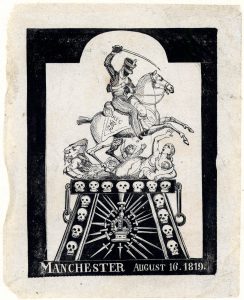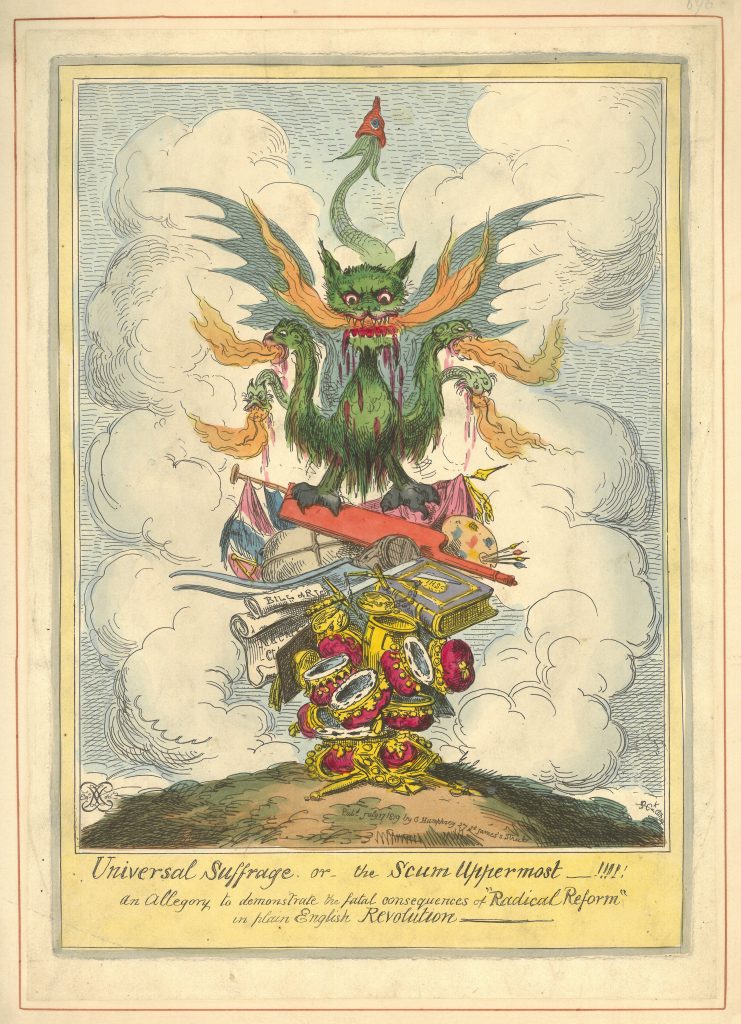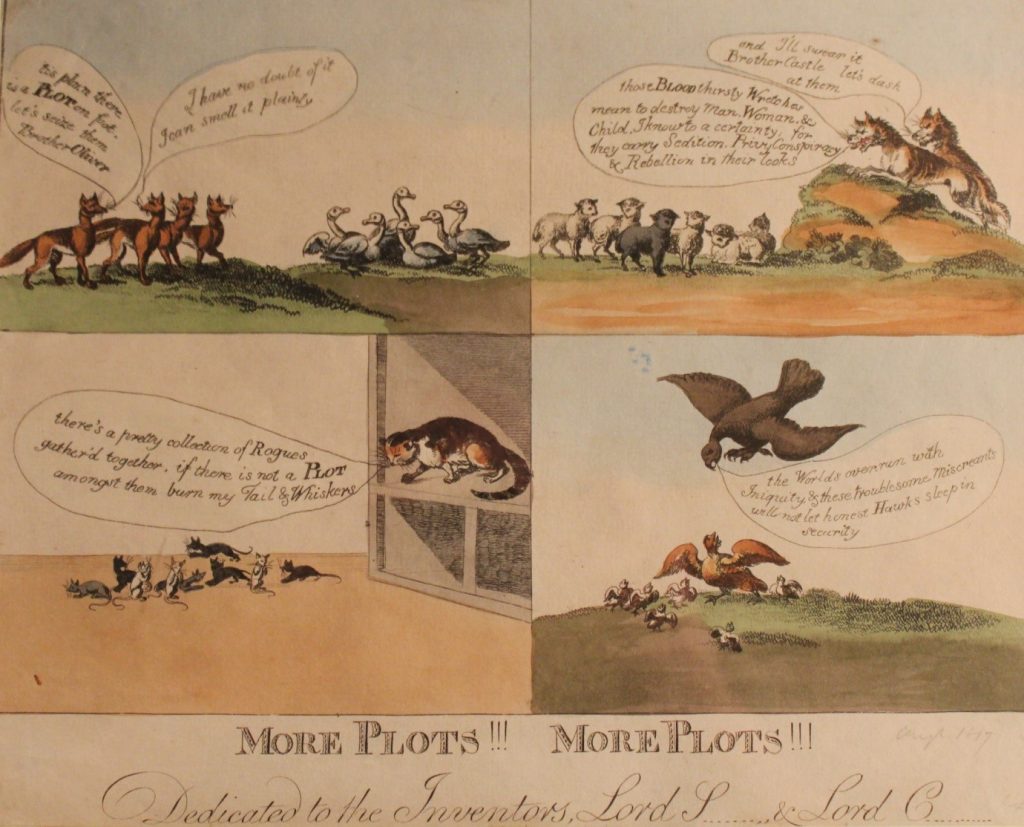PHM Exhibitions Officer Mark Wilson puts the spotlight on a 200 year old cartoon Universal Suffrage or the Scum Uppermost by George Cruikshank.
Over the last few years the Black Lives Matter (BLM) movement has highlighted the relevance and power of mass demonstration and public protest. But the narrative around protest is increasingly shaped by social media and an ever growing number of online news platforms. Despite the increased coverage, the reliability of these news sources has frequently come into question with claims of fake news and disinformation becoming more and more common place. The current media landscape is very different to that of 200 years ago, however it is interesting to draw parallels with how printed propaganda influenced perceptions of protest movements even back then.
Political and satirical cartoons reached the height of their popularity during the late 18th and early 19th centuries. To begin with, satirical prints were only available to upper class collectors. Print shops began to appear everywhere, specialising in single sheet cartoons and publications. The best work was still too expensive for most people, so print shop owners would decorate their windows with the most popular cartoons for everyone to enjoy. Here they found a wider audience amongst the working classes, whose interest in politics and democracy was also growing. Soon cheaper lower quality copies were produced to meet demand and some shops even loaned out prints to taverns for an evening’s entertainment.
To modern eyes these prints may look little more than comic drawings but it is important to understand that newspapers at this time almost never included illustrations. Caricaturists were almost unrivalled as visual journalists. The cartoonist’s use of satire and humour allowed more artistic freedom at a time when the press was greatly restricted. Caricaturists were often merciless in their attacks on public figures and politicians, embellishing every detail of the latest scandal. It was in part due to their popularity that the printers were rarely ever prosecuted for their libellous content, as the fear was a court case would only generate more publicity. Perhaps we can see similarities today with removal of offensive content from social media often only fuelling greater public interest and attention.


George Cruikshank (1792 – 1878) was the son of the noted caricaturist Isaac Cruikshank, he was born during the satirical print’s most fertile period. From an early age he was involved in the family business assisting his father with etching plates, drawing background characters or filling in areas of shadow. It wasn’t long before he was recognised as an artist in his own right and became renowned for his savage caricatures, eventually replacing James Gillray as the nation’s favourite cartoonist. Early in his career Cruikshank achieved great success working with the radical journalist and publisher William Hone. Hone specialised in short illustrated pamphlets which used satire to attack the church and the political establishment. These cheaply produced publications employed minimal text and bold black and white wood engraved illustrations. Their collaborations proved hugely popular often selling over a 100,000 copies in a matter of months.
Cruikshank worked with many publishers and he was illustrating anti-radical prints at the same time he was working with Hone for the reform movement. To some extent his motivation was probably financial, print shops that produced full colour etchings paid better money and he could be bought for the right price as the £100 bribe he accepted to stop caricaturing George IV showed.

Universal Suffrage or the Scum Uppermost!! was a print commissioned by influential London print shop owner George Humphrey. The engraving was produced in July 1819, just one month before the Peterloo Massacre. It was designed to warn of the dangers of radical reform and potential revolution. Humphrey’s customers were mainly wealthy middle and upper class men, many of whom were anxious about the working classes’ growing demands for the vote. The print depicts reform as a multi-headed beast perched atop a smoking mound, made up of the discarded symbols of royalty, religion and the arts. The monster balances a cap of liberty on its tail; an emblem of the French Revolution. The print offers us a window into the attitudes that would directly fuel the events of the Peterloo Massacre on 16 August 1819 in Manchester.
Cruikshank produced many similar anti-reform prints for Humphrey, his motivation may have been largely financial but even he was not immune to Tory propaganda and he was increasing worried about the possibility of bloody revolution in Britain. Although he would continue to produce anti-establishment work in the wake of Peterloo, his wavering commitment to reformist cause was noted by his friend William Hone in a letter from 1821, ‘I have long suspected, that he is by no means friendly to Reform!’

Many believed that Lord Liverpool’s government exaggerated the danger of revolution and even agitated rebellion using agent provocateurs; secret agents that infiltrated the reform movement. This is illustrated by the 1817 satirical print published SW Forbes, More Plots!!! More Plots!!! . The four sections of the image show different animals accusing their prey of plotting against them. In one panel two wolves survey a flock of lambs, speculating ‘those bloodythirsty wretches mean to destroy man woman & child’.
The print is dedicated to Lord Sidmouth and Lord Castlereagh leading members of the government who used the perceived threat of unrest to suspend Habeas Corpus that same year; which allowed people to be detained without trial.
In much the same way that the prints of the golden age of caricature influenced public opinion both positively and negatively, social media and online platforms have been found to increasingly shape political discourse. Some would argue they have even affected the outcome of elections and referendums around the world. The sheer volume of content online means it is sometimes hard to separate fact from fiction.
In 2020, thousands attended mass demonstrations worldwide in support of the Black Lives Matter (BLM) movement. Social media has been used to raise awareness of racism and show solidarity with the movement. In addition to this, a battleground has developed online where the backlash against BLM grows, with more and more attempts to undermine the movement by spreading of disinformation. Some of the most extreme examples can easily be dismissed and traced back to unreliable sources or fake accounts, but their messages seems to have filtered into the narrative of more established news outlets and even that of the US government and former President Donald Trump, who choose to frame BLM as an anti-white movement and claim anti-fascist protesters are being transported around the country to join protests, cause chaos and destroy property. Even in Britain fake protests flyers have been shared on social media which carry inflammatory messages like ‘Kill A white on sight their silence is violence’ and ‘ White women and Children you are the enemy!’ these dangerous hoaxes play to the fears of those who see the movement as an attack on ‘British’ history and life. It important that we don’t allow this rise in online propaganda to discredit such an important international human rights movement and their role in addressing racial inequality.
The cartoon is not on public display. It featured in PHM’s 2019 exhibition Disrupt? Peterloo and Protest exhibition (23 March 2019 – 23 February 2020). You can find out more about the print and all the ten treasures in PHM’s collection.
Read a trio of blogs from our friends at the Working Class Movement Library: a blog about Hone’s 1819 pamphlet The Political House that Jack Built which featured as their Object of the Month in 2012 and two blog posts relating to William Hone’s trials created for the bicentenary in 2017.